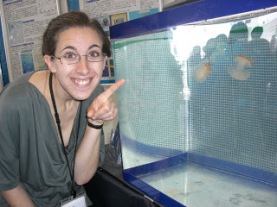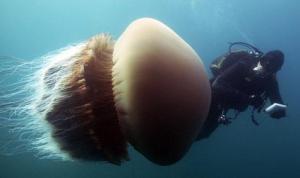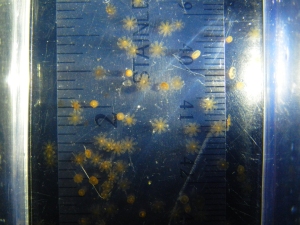Comb Jellies are a fascinating and captivating sea creature. Their beautiful light-show of colors draws the attention of crowds . These odd jellies appear to almost be living spaceships, with colors pulsing up and down their bodies. What are these beautiful weird things and how do we care for them?
Comb Jellies are Not True Jellyfish

We often refer to these guys as “jellies” and not jellyfish because they are not actually true jellyfish. They are actually considered Ctenophores (ten-oh-fours), which is a group of stingless marine creatures. That’s right, they have no ability to sting whatsoever. Unlike Moon Jellyfish, which have very little sting, Comb Jellies substitute sting with sticky tentacles. Think about those sticky hands you would buy in a quarter machine as a kid. Comb Jellies also lack that characteristic pulsing motion that jellyfish have. Instead, Comb Jellies use eight rows of combs, or rows, to bat their way through the water. These combs beat back and forth quickly, and allows the jelly to hover, and have a full 360 degrees of motion.
Their Beautiful Rainbow Color Isn’t bioluminescence

Comb jellies are famous for the stunning rainbow effect they display. Contrary to popular belief, this is not bioluminescence. The jellies are actually breaking up and refracting light, just like a prism would. This is important because they will not display this affect in the dark! To get the greatest refraction effect follow these guidelines:
- Use a bright white light. White light is a combination of all the light colors. This will allow the jellies to create a true rainbow of colors.
- Use a close source point. LEDs are a great example of this. You want a lot of light coming from a small source.
- Add a dark background. This will really help the colors pop, and help you see the jellyfish better.
How to Care For Comb Jellies
The first thing to note here is that we sell Mnemiopsis Leidyi. This is one of the most common and definitely the hardiest species of Comb Jellies available. They are found in many places around the world, including the Atlantic. We collect and find these Comb Jellies in all seasons. They are incredibly versatile, and can exist in waters ranging from 55-78°F, and salinities of 1.020-1.026. With years of research, we have found the most optimal conditions to keep your comb jelly healthy and living the longest.
- Keep your jellies in stable aquariums with no ammonia. Many jellies are tolerant of ammonia, but Comb Jellies cannot stand it. Only add Combs to tanks that are well cycled. Additionally, pH swings can be very damaging to Combs. Monitor the pH often.
- Keep them cold. When kept at a temperature of 60-65°F your Comb Jellies will have much slower metabolisms, and their life span will be extended significantly. Additionally, the cold water will limit harmful bacterial growth.
- Feed them a varied diet occasionally. It’s best to feed your Combs freshly hatched baby brine shrimp on a daily basis. Switch it up every now and then with frozen rotifers and live copepods. They will appreciate the snack!
Literature used to suggest Mnemiopsis Comb Jellies would only live two months. Using the three methods above, we have managed to keep our Comb jellies for well over a year in captivity.
Care Requirements Summed Up
Temperature: 55-78°F, Optimally 60°F
Salinity: 1.020-1.026
Ammonia: 0 ppm
Best Jellyfish Tanks: Orbit 20, Pulse 80, these jellies stay around 2″ long, Orbit & Pulse have ports for a mini chiller. Set flow to very low.
Diet: Will need live baby brine shrimp as main staple. Frozen/ live rotifers and live copepods are good options as well.
Other Species of Comb Jellies
Lastly, there are a few other species of Comb Jellies. They may have special requirements, or are difficult to get ahold of.
Sea Gooseberries: These Comb jellies are a small, round creature, with two long net-like tentacles. They are straightforward and easy to care for, but require a chiller, as they are a coldwater only species.
Beroe Comb Jellies: These are very bizarre jellies, and seem to poses a mouth. This “mouth” allows them to swallow other Comb Jellies (like mnemiopsis) whole. Their diet actually consists only of other Comb Jellies, making them very difficult to feed. They are also extremely delicate and only the most expert jellyfish aquarists should attempt these.
You can buy your own pet Comb Jellyfish and jellyfish aquarium at our online store: Jellyfish Warehouse



 ing animal. They can be found in many different colors and patterns. Despite their delicate looks, these jellyfish make an excellent beginner jellyfish for the home aquarium.
ing animal. They can be found in many different colors and patterns. Despite their delicate looks, these jellyfish make an excellent beginner jellyfish for the home aquarium.


